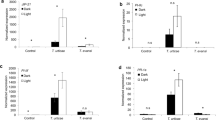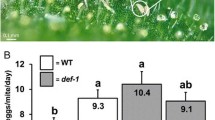Abstract
Herbivorous spider mites occurring on tomato plants (Solanum lycopersicum L.) cope with plant defences in various manners: the invasive Tetranychus evansi reduces defences below constitutive levels, whereas several strains of T. urticae induce such defences and others suppress them. In the Mediterranean region, these two species co-occur on tomato plants with T. ludeni, another closely related spider mite species. Unravelling how this third mite species affects plant defences is thus fundamental to understanding the outcome of herbivore interactions in this system. To test the effect of T. ludeni on tomato plant defences, we measured (1) the activity of proteinase inhibitors, indicating the induction of plant defences, in those plants, and (2) mite performance on plants previously infested with each mite species. We show that the performance of T. evansi and T. ludeni on plants previously infested with T. ludeni or T. evansi was better than on clean plants, indicating that these two mite species down-regulate plant defences. We also show that plants attacked by these mite species had lower activity of proteinase inhibitors than clean plants, whereas herbivory by T. urticae increased the activity of these proteins and resulted in reduced spider mite performance. This study thus shows that the property of down-regulation of plant defences below constitutive levels also occurs in T. ludeni.


Similar content being viewed by others
References
Abramovitch RB, Anderson JC, Martin GB (2006) Bacterial elicitation and evasion of plant innate immunity. Nat Rev Mol Cell Biol 7:601–611
Agrawal AA (2000) Specificity of induced resistance in wild radish: causes and consequences for two specialist and two generalist caterpillars. Oikos 89:493–500
Agrawal AA (2007) Macroevolution of plant defense strategies. Trends Ecol Evol 22:103–109
Alba JM, Glas JJ, Schimmel BCJ, Kant M (2011) Avoidance and suppression of plant defenses by herbivores and pathogens. J Plant Interact 6:221–227
Alba JM, Schimmel BCJ, Glas JJ et al (2015) Spider mites suppress tomato defenses downstream of jasmonate and salicylate independently of hormonal crosstalk. New Phytol 205:828–840
Ali JC, Agrawal AA (2012) Specialist versus generalist insect herbivores and plant defense. Trends Plant Sci 17:293–302
Ament K, Kant MR, Sabelis MW et al (2004) Jasmonic acid is a key regulator of spider mite-induced volatile terpenoid and methyl salicylate emission in tomato. Plant Physiol 135:25–2037
Baldwin IT, Preston CA (1999) The eco-physiological complexity of plant responses to insect herbivores. Planta 208:137–145
Bates D, Mächler M, Bolker B, Walker S (2013) lme4: Linear mixed-effects models using S4 classes. http://CRAN.R-project.org/package=lme4
Belliure B, Janssen A, Maris PC et al (2005) Herbivore arthropods benefit from vectoring plant viruses. Ecol Lett 8:70–79
Belliure B, Sabelis MW, Janssen A (2010) Vector and virus induce plant responses that benefit a non-vector herbivore. Basic Appl Ecol 11:162–169
Boubou A, Migeon A, Roderick GK et al (2012) Test of colonisation scenarios reveals complex invasion history of the red tomato spider mite Tetranychus evansi. PLoS ONE 7:e35601
Bradford MM (1976) A rapid and sensitive method for the quantitation of microgram quantities of protein utilizing the principle of protein-dye binding. Anal Biochem 72:248–254
Broadway R, Duffey S (1986) Plant proteinase inhibitors: mechanism of action and effect on the growth and digestive physiology of larval Heliothis zea and Spodoptera exigua. J Insect Physiol 32:827–833
Burgyán J, Havelda Z (2011) Viral suppressors of RNA silencing. Trends Plant Sci 16:265–272
de Moraes GJ, McMurtry JA (1985) Comparison of Tetranychus evansi and T. urticae (Acari: Tetranychidae) as prey for eight species of Phytoseiid mites. Entomophaga 30:393–397
de Oliveira EF, Pallini A, Janssen A (2015) Herbivores with similar feeding modes interact through the induction of different plant responses. Oecologia. doi:10.1007/s00442-015-3344-0
Denno RF, McClure MS, Ott JR (1995) Interspecific interactions in phytophagous insects: competition reexamined and resurrected. Annu Rev Entomol 40:297–331
Dermauw W, Wybouw N, Rombauts S et al (2013) A link between host plant adaptation and pesticide resistance in the polyphagous spider mite Tetranychus urticae. Proc Natl Acad Sci USA 110:113–122
Dicke M (1994) Local and systemic production of volatile herbivore-induced terpenoids: their role in plant carnivore mutualism. J Plant Physiol 143:465–472
Ferragut F, Garzón-Luque E, Pekas A (2013) The invasive spider mite Tetranychus evansi (Acari: Tetranychidae) alters community composition and host-plant use of native relatives. Exp Appl Acarol 60:321–341
Glas J, Alba JM, Simoni S et al (2014) Defense suppression benefits herbivores that have a monopoly on their feeding site but can backfire within natural communities. BMC Biol 12:98
Glazebrook J (2005) Contrasting mechanisms of defense against biotrophic and necrotrophic pathogens. Rev Phytopathol 43:205–227
Gotoh T, Moriya D, Nachman G (2015) Development and reproduction of five Tetranychus species (Acari: Tetranychidae): Do they all have the potential to become major pests? Exp Appl Acarol 66:453–479
Green TR, Ryan CA (1972) Wound-induced proteinase inhibitor in plant leaves: a possible defense mechanism against insects. Science 175:776–777
Haegeman A, Mantelin S, Jones JT, Gheysen G (2012) Functional roles of effectors of plant-parasitic nematodes. Gene 492:19–31
Herms DA, Mattson WJ (1992) The dilemma of plants: to grow or defend. Q Rev Biol 67:283–335
Hothorn T, Bretz F, Westfall P (2008) Simultaneous inference in general parametric models. Biom J 50:346–363
Jeppson LR, Keifer HH, Baker EW (1975) Mites injurious to economic plants. University of California Press, Berkeley
Kakade ML, Rachis JJ, McGhee JE, Puski G (1974) Determination of trypsin inhibitor activity of soy products: a collaborative analysis of an improved procedure. Cereal Chem 51:376–382
Kant MR, Baldwin IT (2007) The ecogenetics and ecogenomics of plant-herbivore interactions: rapid progress on a slippery road. Curr Opin Genet Devel 17:519–524
Kant MR, Ament K, Sabelis MW et al (2004) Differential timing of spider mite-induced direct and indirect defenses in tomato plants. Plant Physiol 135:483–495
Kant MR, Sabelis MW, Haring MA, Schuurink RC (2008) Intraspecific variation in a generalist herbivore accounts for differential induction and impact of host plant defences. Proc R Soc Lond B 275:443–452
Kant MR, Jonckheere W, Knegt B et al (2015) Mechanisms and ecological consequences of plant defence induction and suppression in herbivore communities. Ann Bot 115:1015–1051
Karban R, Agrawal AA (2002) Herbivore offense. Annu Rev Ecol Syst 33:641–664
Karban R, Baldwin IT (1997) Induced responses to herbivory. Interspecific interactions. University of Chicago Press, Chicago
Karban R, Carey JR (1984) Induced resistance of cotton seedlings to mites. Science 225:53–54
Karban R, Myers JH (1989) Induced plant responses to herbivory. Annu Rev Ecol Syst 20:331–348
Kessler A, Baldwin IT (2001) Defensive function of herbivore-induced plant volatile emissions in nature. Science 291:2141–2144
Kessler A, Baldwin IT (2002) Plant responses to insect herbivory: the emerging molecular analysis. Annu Rev Plant Biol 53:299–328
Koornneef A, Pieterse CM (2008) Cross talk in defense signaling. Plant Physiol 146:839–844
Lawrence SD, Novak NG, Ju CJT, Cooke JE (2008) Potato, Solanum tuberosum, defense against Colorado potato beetle, Leptinotarsa decemlineata (Say): microarray gene expression profiling of potato by Colorado potato beetle regurgitant treatment of wounded leaves. J Chem Ecol 34:1013–1025
Li C, Williams MM, Loh YT et al (2002) Resistance of cultivated tomato to cell content-feeding herbivores is regulated by the octadecanoid-signaling pathway. Plant Physiol 130:494–503
Matsuda T, Fukumoto C, Hinomoto N, Gotoh T (2013) DNA-based identification of spider mites: molecular evidence for cryptic species of the genus Tetranychus (Acari: Tetranychidae). J Econ Entomol 106:463–472
Migeon A, Nouguier E, Dorkeld F (2011) Spider mites web: a comprehensive database for the Tetranychidae. Trends in Acarology. Springer, Dordrecht, pp 557–560
Musser RO, Hum-Musser SM, Eichenseer H et al (2002) Herbivory: caterpillar saliva beats plant defences: a new weapon emerges in the evolutionary arms race between plants and herbivores. Nature 416:599–600
Ozawa R, Arimura GI, Takabayashi J et al (2000) Involvement of jasmonate-and salicylate-related signaling pathways for the production of specific herbivore-induced volatiles in plants. Plant Cell Physiol 41:391–398
Pallini A, Janssen A, Sabelis MW (1997) Odour-mediated responses of phytophagous mites to conspecific and heterospecific competitors. Oecologia 110:179–185
Poelman EH, Dicke M (2014) Plant-mediated interactions among insects within a community ecological perspective. In: Voelckel C, Jander G (eds) Annual plant reviews 47: Insect plant interactions. Wiley, New York, pp 309–338
Poelman EH, Broekgaarden C, Van Loon JJA, Dicke M (2008) Early season herbivore differentially affects plant defence responses to subsequently colonizing herbivores and their abundance in the field. Mol Ecol 17:3352–3365
Reddy GVP (2001) Comparative effectiveness of an integrated pest management system and other control tactics for managing spider mite Tetranychus ludeni (Acari: Tetranychidae) on eggplant. Exp Appl Acarol 25:985–992
Reddy GVP (2002) Plant volatiles mediate orientation and plant preference by the predator Chrysoperlacarnea Stephens (Neuroptera: Chrysopidae). Biol Control 25:49–55
Reddy GVP, Baskaran P (2006) Damage potential of Tetranychus ludeni Zacher (Acari: Tetranychidae) on four varieties of eggplant, Solanum melongena L. Int J Trop Insect Sci 26:48–56
Rostás M, Hilker M (2002) Feeding damage by larvae of the mustard leaf beetle deters conspecific females from oviposition and feeding. Entmol Exp Appl 103:267–277
Sarmento RA, Lemos F, Bleeker PM et al (2011a) A herbivore that manipulates plant defence. Ecol Lett 14:229–236
Sarmento RA, Lemos F, Dias CR et al (2011b) A herbivorous mite down-regulates plant defence and produces web to exclude competitors. PLoS ONE 6(1–7):e23757
Sauge MH, Mus F, Lacroze JP et al (2006) Genotypic variation in induced resistance and induced susceptibility in the peach–Myzus persicae aphid system. Oikos 113:305–313
Silva RS, Ribeiro FR, Queiroz OS et al (2015) Trypsin protease inhibitor activity is not a good proxy for defence against Oligonychus ilicis (Acari: Tetranychidae) in Coffea canephora (Gentianales: Rubiaceae). Int J Acarol 41:189–194
Thaler JS, Humphrey PT, Whiteman NK (2012) Evolution of jasmonate and salicylate signal crosstalk. Trends Plant Sci 17:260–270
Walling LL (2000) The myriad plant responses to herbivores. J Plant Growth Regul 19:195–216
Whitlock MC (1996) The red queen beats the jack-of-all-trades: the limitations on the evolution of phenotypic plasticity and niche breadth. Am Nat 148:S65–S77
Wink M (2003) Evolution of secondary metabolites from an ecological and molecular phylogenetic perspective. Phytochemistry 64:3–19
Wybouw N, Zhurov V, Martel C et al (2015) Adaptation of a polyphagous herbivore to a novel host plant extensively shapes the transcriptome of herbivore and host. Mol Ecol. doi:10.1111/mec.13330
Zangerl AR, Bazzaz FA (1992) Theory and pattern in plant defense allocation. In: Fritz RS, Simms EL (eds) Plant resistance to herbivores and pathogens. University of Chicago Press, Chicago, pp 363–391
Zhao Y, Thilmony R, Bender CL et al (2003) Virulence systems of Pseudomonas syringae pv. tomato promote bacterial speck disease in tomato by targeting the jasmonate signaling pathway. Plant J 36:485–499
Zhu-Salzman K, Bi JL, Liu TX (2005) Molecular strategies of plant defense and insect counter-defense. Insect Sci 12:3–15
Acknowledgments
We thank Felipe Lemos for sending mite strains from Amsterdam, Flore Zélé for all the improvements of the greenhouse facilities, and genetic identification of spider mites, Inês Santos for taking care of plants and mite populations and the whole mite squad (FZ, IS, Leonor Rodrigues, Ana Rita Ponce, Gonçalo Matos and Salomé Clemente) for stimulating discussions. DG thanks Cristina Branquinho for logistic support. This work was funded by an FCT-ANR project (FCT-ANR//BIA-EVF/0013/2012) to SM and Isabelle Olivieri. TM acknowledges a Post Doc grant SFRH/BPD/85419/2012.
Author contribution statement
DG, SM and AJ conceived and designed the experiments. DG performed the experiments, with help from TD and CC in the proteinase activity analysis. DG and SM analyzed the data and wrote the manuscript, with considerable contributions from AJ.
Author information
Authors and Affiliations
Corresponding authors
Additional information
Communicated by Merijn Kant.
Rights and permissions
About this article
Cite this article
P. Godinho, D., Janssen, A., Dias, T. et al. Down-regulation of plant defence in a resident spider mite species and its effect upon con- and heterospecifics. Oecologia 180, 161–167 (2016). https://doi.org/10.1007/s00442-015-3434-z
Received:
Accepted:
Published:
Issue Date:
DOI: https://doi.org/10.1007/s00442-015-3434-z




